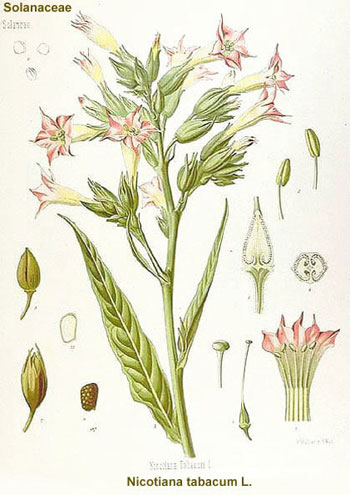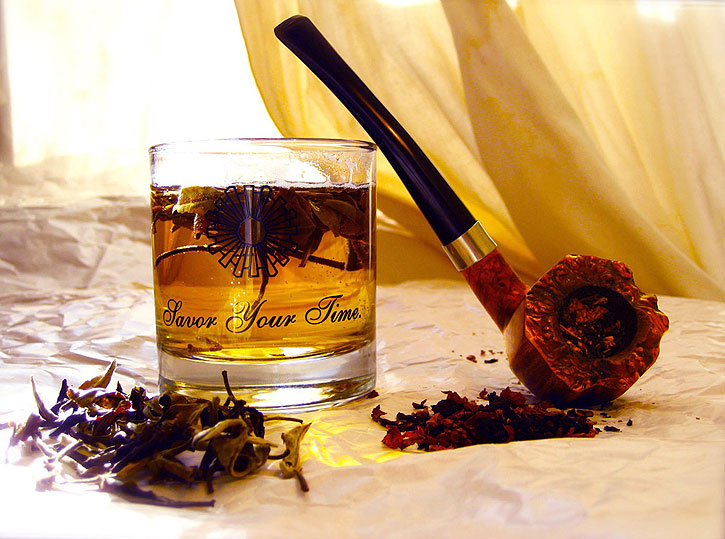By E. Roberts

A cup of tea and a pipeful of tobacco are a sublime combination; one that speaks to a contemplative repast, a sense of ritual, and a repudiation of worldly cares. It may not be surprising that tea is the most popular prepared beverage in the world, second only to water in consumption; tobacco is likewise one of the most popular entheogens, or mind-altering substances, currently used by an estimated 1.2 billion worldwide. To chart the historical trajectories of these two plants, however, one is struck by their many intersections and similarities—and by the profound impact they have had on human culture. Because of these unassuming leaves, wars have been waged, nations born and empires toppled, fortunes built and lost, and politics divided on a global scale.
Tea, Tobacco, Terroir
All tea is made from a single species of plant, Camellia sinensis; the different varieties of tea—white, green, oolong, black, and pu-erh—are dependent both upon the region where they are grown and the ways in which the leaves are harvested and processed. For example, an Assam tea is still C. sinensis, though from a cultivar that is indigenous to the northeast Indian state.
Similarly, modern tobacco products are mainly derived from a single plant, Nicotiana tobacum. Although there are several subspecies of tobacco, including N. rustica and N. africana, they are largely uncultivated. Once harvested, the leaves of both plants are subject to various processes of curing, including wilting, bruising, curling, oxidizing, fermenting, heating, steaming, rolling, aging, and several means of drying—some in the sun, some in the shade, some over heated flues or smoky fires. The leaves of both crops are carefully selected and graded, then set aside to age in controlled environments, allowing the aspect of time to work its magic on them.
 |
 |
The net result of all this handling is to control the internal decay of the plant’s cells, to regulate the distribution and combination of water and oxygen, sugars and aromatic oils. The soul of the leaves must be coaxed out through these mechanical and metabolic processes, to be finally released when, paradoxically, either immersed in boiling water or set aflame.
Both plants express their flavors through the natural history of their environments in a term we call terroir, which encompasses the geography, geology and climate in which they are grown. The concept originated with viticulture, and is used with reference to coffee as well. That these crops so clearly denote their origins is another one of the mysteries of the leaves.
Origins
Shen Nung, the second Chinese Emperor, purportedly enjoyed the first cup of tea in the year 2737 BC. He was a scholar, skilled in herbal lore and medicine, and insisted that water be boiled to make it potable—roughly forty-six hundred years before Pasteur discovered bacteria. As the legend goes, he was traveling far into the countryside with his retinue and stopped beside a forested stream for their afternoon meal when some leaves from a wild tea tree chanced to fall in the water pot. Noting the pleasant aroma, he drank of the brew, and immediately felt the soothing yet invigorating effects; he declared it a boon from the gods, and thus began tea’s journey. For more than a thousand years, tea slowly infiltrated Chinese culture, at first primarily as a medicinal herb, then as its cultivation and use became more widespread, as a prized beverage and trade commodity. By the first century, when the Silk Road was merely a dirt track, tea was being traded with neighboring India and points south, even being pressed into coinage; by the sixth century it was bartered with the Turks, and had become the universal beverage in its homeland. Except for a brief period following the Mongol conquest of China, when tea drinking was discouraged, tea literally and figuratively dug its roots deep into Asia.
Both Confucius and the Bodhidharma were documented tea drinkers; indeed, the salutary effects of tea on meditation have entwined it with the religious aspect of Eastern cultures to such an extent that myth and ceremony have merged. One such story, often repeated, is that of Bodhidharma on his visit to the Shaolin monks. Refused entry to the temple, he took up residence in a nearby cave and proceeded to stare at the wall in deep meditation. During his seventh year of this wall-gazing, the Bodhidharma fell briefly asleep; angered at his transgression, he sliced his eyelids off to prevent further lapses. As his eyelids fell to the floor, miraculously there sprang up tea plants. Forever after, tea would be used to assist students of Zen to remain awake during their meditations. The Japanese formal tea ceremony is another such expression of chado, the way of tea, as a complex of ritual preparation that serves as Zen practice. Through precisely choreographed motion and specialized accoutrements, one observes the calming of the mind within, the communion of one’s fellow man without, and the encompassing aesthetic of asymmetry, simplicity, and appreciation of natural beauty. To this day, tea culture permeates China, Japan, and all of Southeast Asia, from street-side chaiwallas to formal receptions for heads of state.
 The tobacco plant’s history has been pinpointed to the Pleistocene era—2.5 million years ago, in the Maranon river basin in northeastern Peru. The indigenous people discovered its remarkable properties at some point that can only be described in legend. Henry Schoolcraft’s recollection in his Historical and Statistical Information respecting the Indian Tribes of the United States (Philadelphia, 1851-57) provides one such creation myth: at a time when the Earth was still fair enough for the spirits to take up residence, a very powerful warrior lay beside his fire to sleep. An enemy spirit happened upon him thus, and decided to roll him into the fire. Hair ablaze, the warrior spirit ran screaming through the forest, and wherever the burning hair fell, up from the ground sprang tobacco.
The tobacco plant’s history has been pinpointed to the Pleistocene era—2.5 million years ago, in the Maranon river basin in northeastern Peru. The indigenous people discovered its remarkable properties at some point that can only be described in legend. Henry Schoolcraft’s recollection in his Historical and Statistical Information respecting the Indian Tribes of the United States (Philadelphia, 1851-57) provides one such creation myth: at a time when the Earth was still fair enough for the spirits to take up residence, a very powerful warrior lay beside his fire to sleep. An enemy spirit happened upon him thus, and decided to roll him into the fire. Hair ablaze, the warrior spirit ran screaming through the forest, and wherever the burning hair fell, up from the ground sprang tobacco.
A bit more animated than the discovery of tea, to be sure, though there are several Chinese tea myths that involve dragons and fire. At any rate, by around 1 BC the natives had begun finding ways to enjoy the stimulating effects of tobacco, including smoking it in many forms, chewing, and even hallucination-inducing enemas. The Mayas further developed tobacco’s usage both as a medicinal herb and for its pleasurable properties, and passed it on to the Toltecs and other tribes as far north as the Mississippi River Valley, and it, like tea, became the focus of ceremony and communion with the divine. Many native North American tribes took their tobacco in the form of a pipe, the oldest surviving examples of which date back over four thousand years, at around the same time a certain emperor was discovering tea half a world away.
By the time Columbus reached the Bahamas in 1492, the Arawak Indians had been rolling primitive cigars for generations, as well as inhaling snuff. From the natives’ perspective, this magical substance, which excited the body and the mind, was surely otherworldly; it was transportive for them, and spirits revealed themselves in the curls of smoke. Columbus himself was rather nonplussed by this strange, fragrant plant, even remarking in his journal that the dried leaves they were gifted by the natives were tossed overboard. While in Cuba—searching, incidentally, for the Emperor of China—his companion, Rodrigo de Jerez, was amazed at the way the natives sipped smoke from these "muskets" of rolled leaves, and immediately became a confirmed smoker. Unfortunately for him, this bizarre practice would take some getting used to back in Spain. Frightening his neighbors with the exotic ritual of breathing fire and smoke, Jerez’ new habit led to speculation that he was in league with the Devil, and the Spanish Inquisition summarily locked him up for seven years. Even more lamentably for him, by the time he was released smoking had become quite the popular pastime.
The 16th century was roiling with change in Europe, and it is then that the stories of tea and tobacco converge. In the next installment of this article, we’ll survey a tumultuous 250-year period during which tea and tobacco become the foci of nation building and all-out war.

Photo Credit: E. Roberts © 2012 PipesMagazine.com



















Nice read. I’m looking forward to the next installment!
Great first article in this new column.
While I usually drink coffee with my smokes I do enjoy green tea with ginger along with my evening pipe.
Looking forward to the coming installments!
TEA! Almost as important to me as tobacco. The two leaves I couldn’t live without.
Wonderful article. For some reason I always seem to drink tea most when I’m feeling a little under the weather. I think I need to give drinking tea in combination with the pipe a try. Coffee may have to make some room.
@ mark & OTD–crap, this means I have to write them now…
@Withnail — my sentiments exactly!
@Chris–regular tea drinking can keep you from getting under the weather, my man–and I hate to come close to disparaging coffee, as it was my first love, but the variety of flavors available in tea puts coffee to shame. There’s plenty of room, in other words 🙂
Great article! Learned a few things, about tea especially, that I did not know!
Great read Romeo – I for one enjoy coffee with my pipes, but it also depends on what I’m smoking, if not coffee, I’ll go with Sweet Tea or on the hot side, a nice cup of Earl Grey tea.
BTW – really liking that last pic 🙂 !
Ditto on the Earl Grey hot, and the excellent pic. I really enjoyed the parallels drawn between two of my preferred vices; and I find it interesting that ritualizing either of them makes the experience better, somehow. Great article. Looking forward to more of same.
Fantastic article!
Great article!
What a really great read; a terrific blend of the scholarly and the anecdotal. I look foward to reading the next part!
I’ve gotta say this is one of the most captivating, informative articles I’ve read in quite some time. I grabbed my pipe, a small carafe of oolong and had a nice refreshing smoke. Gorgeous photos I must add. Look forward to the next installment…
@ Paul & M. Thomas–thanks, I’m glad people noticed the picture! I’m a hack, but I enjoy being a hack. And thanks to Kevin for re-formatting the article again to retain the punctuation; I know it’s a p.i.t.a.
Excellent research and very well written Romeo. You inspired me to fire up my father’s antique meerschaum along with a steamy Earl Grey. Please keep the articles coming!
Fantastic read..having been diagnosed with diabetes several years ago I started drinking bulk green gunpowder tea and have found it to be great in managing my sugar levels,weight and management of my diabetes. looking foward to the next installments….I am now a confirmed tea drinker..enjoying a cup of egg nog tea now…
Funn
I enjoy my pipe and I enjoy Tea. I just never enjoyed them together. I’ll have to try that. Life keeps getting better and better.
I first discovered this pleasure yesterday morning. I was sitting at my pc with a fresh cup of Republic of Tea’s “Lucky Irish” morning tea. Meanwhile, I was puffing on a corn cub pipe filled with Dunhill’s “Early Morning Smoke.”
The taste of the combo was unbelievably great!